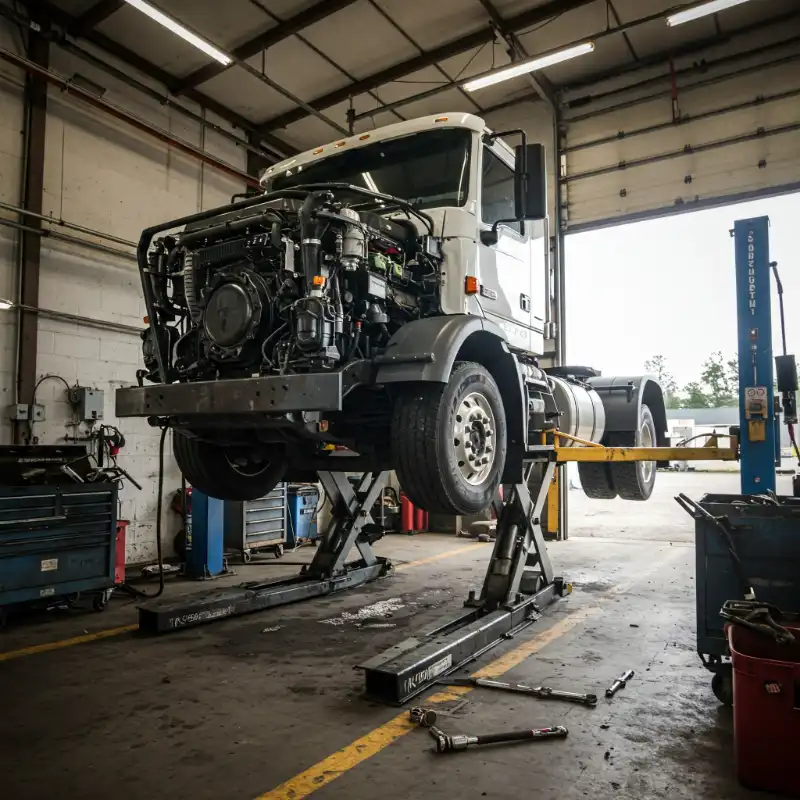For those in the commercial trucking industry, understanding heavy-duty braking systems is important. This guide dives into the components, mechanics, and safety innovations of heavy-duty truck brakes.
If you are in need of expert brake repair services, please visit our Brake Repair page here.
Components of Heavy-Duty Truck Brake Systems
Air Compressor
The air compressor is the heart of the air brake system in heavy-duty trucks. It generates the necessary air pressure that powers the entire braking mechanism. Typically driven by the truck's engine, the air compressor takes in atmospheric air, compresses it, and sends it to the air reservoirs. Maintaining air pressure is crucial because inadequate pressure can lead to brake failure, posing significant safety risks.
Air Reservoirs
Air reservoirs, also known as air tanks, store the compressed air produced by the air compressor. These tanks ensure that there is a sufficient supply of air available for the brake system, even if the compressor temporarily stops working. Most trucks are equipped with multiple reservoirs to provide redundancy and to ensure the system has a backup supply of compressed air in case of a primary tank failure.
Brake Chambers
Brake chambers convert air pressure into mechanical force. When the driver applies the brake pedal, air is directed into the brake chamber, pushing a diaphragm or a piston. This movement then actuates the push rod, which applies force to the slack adjusters and, subsequently, to the brake shoes. Brake chambers are available in various sizes and specifications, each suited to different vehicle requirements.
Slack Adjusters
Slack adjusters play a critical role in maintaining the correct distance between the brake shoes and the brake drum. They automatically adjust for wear and tear in the brake shoes, ensuring consistent brake performance. Properly functioning slack adjusters are essential for effective braking, as they prevent excessive slack, which can lead to reduced braking efficiency and increased stopping distances.
Brake Drums
Brake drums are one of the most common components in heavy-duty braking systems, as opposed to disc brakes used in many smaller passenger vehicles. The brake drum is a large, drum-shaped component that rotates with the wheel. When the brake is applied, the brake shoes press against the inner surface of the drum, creating friction that slows the vehicle. The drum's material and design are crucial for effective heat dissipation, ensuring that the brakes do not overheat during prolonged use.
Brake Shoes and Linings
Brake shoes are fitted with brake linings made from high-friction materials designed to withstand high temperatures and stresses. These linings are pressed against the brake drum to create the necessary friction to slow the truck. The materials used for brake linings must balance durability, heat resistance, and friction properties to ensure optimal performance and safety.
S-Cam and Camshaft
The S-Cam and camshaft mechanism is essential in actuating the brake shoes. When the brake pedal is pressed, the S-Cam rotates, pushing the brake shoes apart and against the drum. The camshaft's precise movement ensures that the shoes are evenly pressed against the drum, providing stable and effective braking.
Mechanics of Heavy-Duty Truck Braking
How Air Brakes Work
Air brakes in heavy-duty trucks follow a straightforward yet robust process.
- The driver presses the brake pedal, initiating the braking process by releasing compressed air from reservoirs.
- Released air travels through brake lines, reaching the brake chambers located near the wheels.
- The incoming air pressure activates a diaphragm within each brake chamber, causing it to move.
- Movement of the diaphragm pushes a connected push rod, transmitting force to other components.
- The push rod's motion engages the slack adjuster, which rotates the S-Cam, spreading brake shoes against the drum, creating friction, and slowing the vehicle.
Friction and Heat Management
Friction is the fundamental principle behind braking. However, the significant friction generated during braking also produces a considerable amount of heat. Effective heat management is crucial to prevent brake fade—a condition where brakes lose effectiveness due to excessive heat. Brake drums and linings are designed to dissipate heat efficiently, and some systems incorporate additional cooling mechanisms to maintain brake performance.
Brake Force Distribution
Ensuring balanced brake force distribution across all wheels is essential for safe and effective braking. Disproportionate braking can lead to skidding, loss of control, and increased wear on certain brakes. Modern braking systems often include devices like load-sensing valves that adjust the brake force according to the vehicle's load, ensuring even distribution and preventing wheel lockup.
Safety Features and Innovations
ABS (Anti-lock Braking Systems)
ABS is a critical safety feature in modern heavy-duty trucks. It prevents wheel lockup during emergency braking by modulating brake pressure. This technology maintains traction and steering control, reducing the risk of skidding and collisions. ABS is particularly beneficial in adverse weather conditions where road grip is compromised.
EBS (Electronic Braking Systems)
EBS takes brake control a step further by incorporating electronic controls. Unlike traditional pneumatic systems, EBS uses electronic signals to manage brake application, allowing for faster and more precise brake responses. EBS systems often integrate with other vehicle systems like traction control and stability control, enhancing overall vehicle safety and performance.
Brake Monitoring Systems
Modern trucks are increasingly equipped with advanced brake monitoring systems. These systems provide real-time data on brake performance, wear levels, and potential faults. By alerting drivers and fleet managers to issues before they become critical, these systems help maintain optimal brake function and reduce the risk of brake-related accidents.
Final Thoughts
Understanding the workings of heavy-duty truck brake systems is essential for anyone in the commercial trucking industry. From the air compressor to the advanced electronic braking systems, each component plays a role in ensuring safety. By staying informed and proactive about brake system maintenance and advancements, truck operators can ensure their vehicles remain in top condition.










.webp)





























